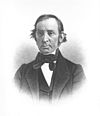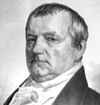These are tables of congressional delegations from Vermont to the United States Senate and United States House of Representatives.
Vermont's 1st congressional district is an obsolete district. Vermont currently has one representative to the United States House of Representatives, elected statewide at-large. Until 1933, however, the state used to have multiple seats spread out into geographic districts. During that time, the first district elected its own representative.
Nebraska's 5th congressional district is an obsolete district. It was created after the 1890 United States census and eliminated after the 1940 United States census.
New York's 21st congressional district is a congressional district for the United States House of Representatives that is represented by Republican Elise Stefanik.
Michigan's at-large congressional district may refer to a few different occasions when a statewide at-large district was used for elections to the United States House of Representatives from Michigan.
Maine's 3rd congressional district is an obsolete congressional district. It was created in 1821 after Maine achieved statehood in 1820 as part of the enactment of the Missouri Compromise. It was eliminated in 1963 after the 1960 U.S. census. Its last congressman was Clifford McIntire.
Maine's 4th congressional district was a congressional district in Maine. It was created in 1821 after Maine achieved statehood in 1820 due to the result of the ratification of the Missouri Compromise. It was eliminated in 1933 after the 1930 U.S. census. Its last congressman was Donald F. Snow.
Maine's 5th congressional district was a congressional district in Maine. It was created in 1821 after Maine achieved statehood in 1820. It was eliminated in 1883. Its last congressman was Thompson Henry Murch.
Maine's 6th congressional district is a former congressional district in Maine. It was created in 1821 after Maine achieved statehood in 1820. It was eliminated in 1863. Its last congressman was Frederick A. Pike.
Maine's 7th congressional district is an obsolete congressional district in the U.S. state of Maine. It was created in 1821 after Maine was admitted to the Union in 1820. The district was eliminated in 1853 following the 1850 census. Its last congressman was Thomas Fuller.
Mississippi's 5th congressional district existed from 1855 to 2003. The state was granted a fifth representative by Congress following the 1850 census.
Alabama's 8th congressional district, now obsolete, was established in 1877.
From the state's creation August 10, 1821 until the end of the 29th United States Congress, and also for the 73rd Congress (1933–1935), Missouri elected its members of the United States House of Representatives at-large statewide on a general ticket.
Florida's at-large congressional district may refer to a few different occasions when a statewide at-large district was used for elections to the United States House of Representatives from Florida. The district is obsolete.
From statehood in 1867 until 1883, Nebraska had only one congressional district. Its representative was elected at-large statewide.

Connecticut's 6th congressional district is a former district, which was eliminated in 2003, following the 2000 census. It was initially created in 1837 from Connecticut's at-large district, yet was eliminated after the 1840 census. In 1965, following passage of the Voting Rights Act, it was re-established.
Vermont's 2nd congressional district is an obsolete district. It was created upon Vermont's admission as the 14th state in 1791. It was eliminated after the 1930 census. Its last congressman was Ernest W. Gibson, who was redistricted into the at-large district.
Vermont's 3rd congressional district is an obsolete district. It was created in 1803. It was eliminated after the 1880 census. Its last congressman was William W. Grout.
Vermont's 4th congressional district is an obsolete district. It was created in 1803. It was eliminated after the 1850 census. Its last congressman was Thomas Bartlett, Jr.
Vermont's 6th congressional district is an obsolete district.








